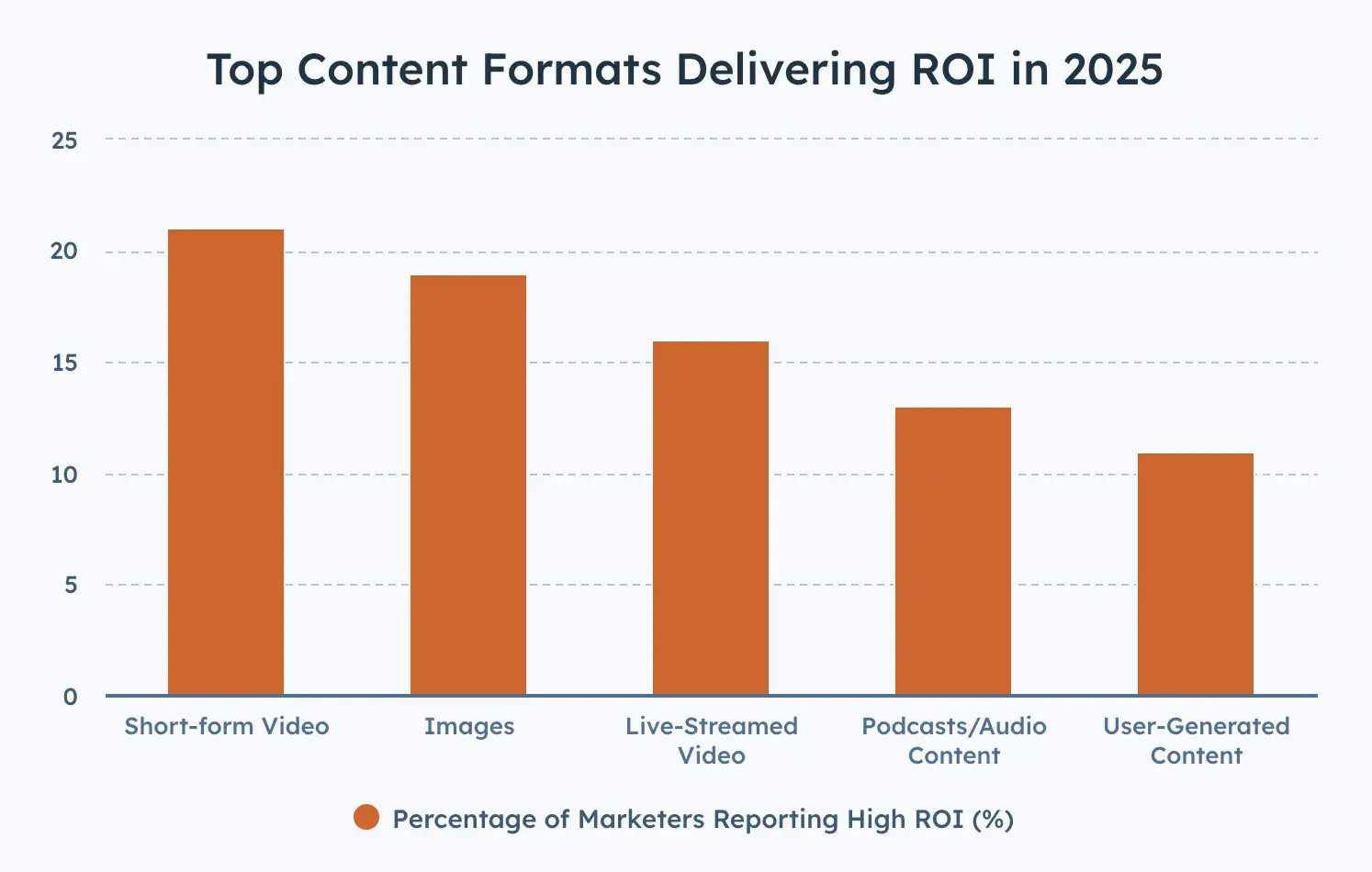Now Reading: 25 Live Video Stats Marketers Need to Know This Year
-
01
25 Live Video Stats Marketers Need to Know This Year
25 Live Video Stats Marketers Need to Know This Year

As a content marketer, I’m always on the hunt for effective ways to deliver content that will result in more customers and conversions. Video has grown into an essential marketing platform, and social media is rewarding those who prioritize a live approach. I’ve narrowed down the top live video stats to give you and your teams a better picture of what’s trending this year in live video marketing.
Classic and emerging platforms like YouTube, Facebook, Instagram, TikTok, LinkedIn, Whatnot, and Twitch.tv cater specifically to live streaming, with good reason. I’ve learned that viewers find live streams engaging because they offer a chance to see raw, authentic footage, go behind the scenes, watch product tutorials, interact with influencers, or participate in live Q&As with industry experts.
When it comes to streaming live video, the creative possibilities seem endless. Good news and bad news: Revenue potential just went way up, but the where-to-start factor can feel daunting. Review the most recent live video stats to inform your team’s strategy.
Table of Contents
25 Live Video Stats That Marketers Need to Know
Growth in Live Video
- In a 2023 survey, 81% of companies reported they had a marketing budget dedicated solely to video. (HubSpot)
- In Q3 2023, live video streams were the third most popular type of online video. (Go-Globe)
- The revenue of the global live-streaming market increased from $1.24 billion in 2022 to $1.49 billion in 2023. (Go-Globe)
- The live-streaming video market is projected to reach $416.84 billion by 2030. (Grand View Research)
- Marketers placed live video third among the most engaging types of videos. (HubSpot)
- “Live commerce,” a format where buyers specifically purchase during a live stream, is growing globally, with 49% of users in the U.S. reporting they’d like to spend more money through this format. (McKinsey)

How Live Streaming Benefits Brands
- 46% of brands and marketers use live video as a social media tactic. (Go-Globe)
- 91% of consumers want to see more online video content from brands. (Go-Globe)
- 37% of viewers consider live video the most engaging type of content on their media feeds. (Restream)
- 20% of U.S. adults between 18-34 watch live stream video several times a day. (Statista)
- 27% of all internet users watch live-streaming content on a weekly basis. (Restream)
- Only 19% of the videos brands post on Facebook are live, compared to 81% of pre-recorded videos. (Influencer Marketing Hub)
Live Streaming Platforms
- Most popular live streaming platforms include Twitch, YouTube Live, Instagram Live, X, LinkedIn Live, and Livestream by Vimeo. (Influencer Marketing Hub)
- In Q3 of 2023 alone, viewers consumed 7.6 billion hours of live content across all platforms. (Demand Sage)
- In total, Twitch has clocked over 9.3 billion hours watched worldwide. (TechJury)

- YouTube Live had more non-gaming viewing hours than Twitch in Q2 2023. (Glo-Globe)
- For live streaming, 52% of viewers prefer YouTube to other platforms, and 42.6% of viewers prefer Facebook. (Demand Sage)
- Kick, a new live video streaming platform, reached 1 million users within its first few months. (Restream)
- TikTok saw the biggest positive increase in brand usage from 2022-2023, with a 16% gain. (Hootsuite)
Live Stream Audience Behaviors and Content Preferences
- On Facebook, live video dominates user engagement with three times the median interactions compared to carousels. (Emplifi)
- Live video on LinkedIn gets 24 times more comments than native video. (LinkedIn)
- 43% of young adult users in the U.S. prefer Instagram Live over other types of video on the platform. (Statista)
- People who engage in live streams are 43% more likely to buy a premium product. (GWI)
- At the end of 2023, live videos were more popular among viewers than educational or tutorial videos. (Statista)
- Watching a live video increases the likelihood of buying an event ticket by 67%. (Eventbrite)
Why use live streaming for B2B?
I’ve found that there are lots of great reasons for using live streaming for your B2B — and there’s never a better time to get started than now. Here are some compelling reasons to begin investing in live video.
Live video enhances B2B purchasing.
More employees than ever are working from home — which has left them physically isolated from interaction. As we know, this shift also included positions in charge of purchasing.
Live video has come to fulfill a basic need and offer a more natural format for interaction and purchasing. In fact, social video is currently the most trusted form of content influencing B2B buyers. I often find myself being influenced by live video, especially when I’ve already been exposed to a product and want to determine if I’m a good fit.
There’s something special about a live event. Customers feel involved and in the know and can ask questions with immediate answers. So don’t sleep on live video, especially when trying to increase B2C purchasing in 2025.
You can always start small with the HubSpot clip creator tool and make an AI-powered video clip for your website.
Pro tip: Choosing who will be the face of your live video is very important. Look for someone at your company who is charismatic, not afraid to be in front of a camera, and knowledgeable. If you don’t have someone like this in mind, consider hiring a paid actor to deliver your message.
Live streams increase internal communication for B2B.
At B2B companies, internal communications play a key role in sales, and live streams provide opportunities for engagement that text and recorded video can’t. In fact, 53% of companies broadcast or stream live video to employees at least once per week.
At my current company, live videos (webinars) are currently our most profitable form of content. They’re also great for recycling content, as a webinar can be turned into a handout, a blog, and more.
Pro tip: Be sure to promote your upcoming live videos and webinars sufficiently. You want to build significant hype around your event, with frequent reminders for those attending.
Live video can expand your B2B marketing reach.
Live streaming has the potential to be exciting for both the seller and the buyer. If a brand gains a reputation for entertaining and/or useful live video events, the potential for significant gains in reach is there.
Employees with purchasing power have more flexibility than ever when it comes to what and when they consume content related to their role. Aim to provide consistent entertainment and value for your B2B targets.
Pro tip: To reach new audiences, you have to meet them where they are at. Consider your advertising spending and which platforms you’ve already targeted. There may be untapped opportunities on platforms such as LinkedIn, Facebook, Instagram, and others that you haven’t already invested in. Don’t be afraid to switch things up!
Planning Your Live Video Strategy
As live video and streaming events increase across most platforms, viewer behavior will adjust according to factors like production, content, and what features become available. Consider which resources you have on hand and what new tools could augment your current capabilities.
You will want to consider appropriate platforms that align with your brand in terms of demographics, usage, and purchasing behavior. At times, you may want to target audience niches with narrow viewership and specific viewing times.
But you may also want to use live streaming for general brand awareness to a large audience. For example, Facebook Live is a great option due to the platform’s age and its number of users. On the other hand, if you want to reach gamers or Gen Z, you might want to test out a Twitch stream.
If you’re interested in creating your own live campaigns but don’t know where to start, here’s a great guide to help you.
Trying to pick out the right live-streaming platform for your brand? Check out this post that directly compares Facebook Live and YouTube. You can also read up on Twitch, one of the fastest-growing live platforms.
Pro tip: If you don’t already have a marketing template, you need one. Check out HubSpot’s free marketing template to get started.
Start Using Live Video Streaming Now
Identifying these stats taught me that even though live streaming has been around since the ‘90s, the 2020 pandemic’s effect on isolation combined with consumer preference has fueled the recent rapid growth of live video events for brands. It’s clear a wave of live and streamed videos is crashing over many platforms, demographics, and marketing budgets.
As I cited above, projections extending to 2030 predict live video has the potential to overtake more familiar forms of online marketing. Enhancing your marketing strategy to include or increase live video production will become increasingly important as time goes on.
In the meantime, I encourage you to play around with the HubSpot Clip Creator to start adding video to your ads, website, social media, and more.
Editor’s note: This post was originally published in May 2020 and has been updated for comprehensiveness.



![→ Access Now: Video Marketing Starter Pack [Free Kit]](https://no-cache.hubspot.com/cta/default/53/8f27c677-d952-4663-8787-bf65c6a1ecf2.png)























:max_bytes(150000):strip_icc()/TSLAChart-e765f60eb31a476d8baf0a98390b5c68.gif?w=150&resize=150,150&ssl=1)
